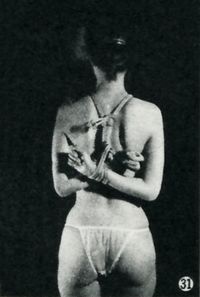Gote takatekote
後手高手小手 (Japanese)
The gote takatekote is one of the principal tying techniques in modern Japanese kinbaku. It has many alternative names including takatekote (高手小手) and gote shibari (後手縛り). It also has more than one way to read the name, for example: gote takatekote, ushirote takatekote and ushirode takatekote.
Alternative "Readings"
- Gote takatekote
- Gote takategote
- Ushirode takatekote
- Ushirode takategote
- Ushirote takatekote
- Ushirote takategote
Alternative names
- Box tie (English)
- Chest harness (English)
- Gote munenawa shibari (後手胸縄縛り)
- Gote shibari (後手縛り)
- Kotetaka (小手高)
- Munenawa (胸縄)
- Takakote (高小手)
- Takatekote (高手小手)
- Takatekote shibari (高手小手縛り)
- Ushiro takatekote (後高手小手)
- Ushiro takatekote (後ろ高手小手)
- Ushiro takatekote Shibari (後高手小手縛り)
- Ushirote takatekote (後ろ手高手小手)
- Ushiro kote shibari (後小手縛り)
- Ushirode shibari or ushirote shibari (後ろ手縛り)
Analysis

Gote indicates that the wrists are tied behind the back.
Takate is an old word referring to the the upper arm. This word can also be understood to represent a high position of the arms.
Kote is an old word referring to the lower arm and/or wrist.
Usage
USAGE 1: Bondage that positions the wrists behind the back and rope is wrapped above and below the breasts where upper arms are fixed (see figure). The wrists are not necessarily in a high position.
USAGE 2: When takate is interpreted as a high position, the wrists must be in a high position. In this case, gote shibari (or ushirote shibari) is used to represent the state in which the wrists are not in a high position.
USAGE 3: Bondage that positions the wrists on the back, and the rope from the wrists is wrapped diagonally over the shoulders to form an "X" shape on the chest. The hands in this usage are often lifted into a high position.
USAGE 4: For most tying in hojojutsu, takate, kote and neck are key positions that must be tied. In this sense, they can belong to gote takatekote (see for instance, Tsujimura's early shibari).
Gote Takatekote in magazines
- Takashi Tsujimura・Tetsuzo Tsukamoto, "On the Beauty of Kinbaku in Gote Takatekote", Kitan Club1953.4, Article
- Koji Sugihara, "Takatekote", Kitan Club1954.4, Photo
- Tetsuzo Tsukamoto, "How to Take Kinbaku Pictures: Examples of Gote Takatekote", Kitan Club1961年.9, Article
- Tetsuzo Tsukamoto,『"How to Take Kinbaku Pictures: Examples of Kubinawa and Goteshibari", Kitan Club1962.4, Article
- Unknown, "Gote Takatekote with Black Nawa and a Bar", Kitan Club1964.2, Photo
Gote Takatekote in art works
- 1888, Eitaku Kobayashi.
- 1924, Sengai Igawa
- 1947, Sentaro Iwata
- 1948, Kazuya Naka
- 1950, Toshiyuki Suma's work in Kitan Club July.
- 1951, Toshiyuki Suma's work in Kitan Club February.
- 1952, Tatsumi Shimura
- 1952, Toshiyuki Suma's work in Kitan Club July.
- 1952, Toshiyuki Suma's work in Kitan Club September.
- 1953, Kentaro Tominaga
- 1953, Toshiyuki Suma's work in Kitan Club March.

